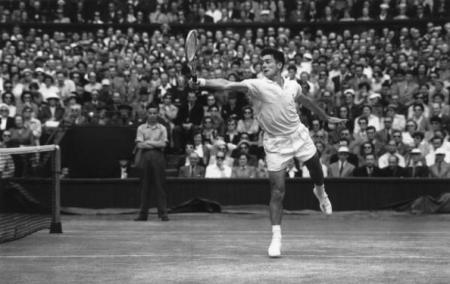
Roger Federer hitting a forehand during the 2008 US Open
Just one year ago it seemed a foregone conclusion that Roger Federer would break–no, smash–Pete Sampras’s record of 14 Grand Slam titles. Now, with the Swiss stalled at 12 and rival Rafael Nadal taking over as the top-ranked tennis player in the world, that future appears somewhat less than certain. Many commentators have claimed that surpassing Sampras’s mark is one of the two main obstacles standing in Federer’s way toward becoming the mythical “GOAT” or “Greatest Of All Time” (the other, of course, being victory on the clay courts of Roland Garros). I have always argued that Sampras’s 14 Slams do not represent a useful historical benchmark for assessing greatness, so I would like to take a few moments to make that case here, and to suggest what a more appropriate measure would be.
Anyone attempting to compare players’ achievements over time must contend with the fact that for about 40 years, from the late 1920s to the late 1960s, many of the best players in the world were banned from competition in the Grand Slam tournaments. Prior to the dawn of the Open Era in 1968, the so-called “Slams” were exclusively amateur affairs, and they stubbornly remained so even as the rest of the tennis world moved increasingly toward professionalism. In 1927 Vinnie Richards became the first prominent male star to turn pro, and after that nearly every great champion of the game would follow suit: Bill Tilden, Ellsworth Vines, Fred Perry, and Don Budge in the 1930s; Bobby Riggs, Jack Kramer, Pancho Segura, and Pancho Gonzales in the 1940s; Frank Sedgman, Tony Trabert, Lew Hoad, and Ken Rosewall in the 1950s; Rod Laver and many others in the 1960s. Clearly, in evaluating these four decades of tennis history, the amateur Slam titles cannot be used as the sole standard of achievement, when so many all-time greats were on the separate pro circuit.
Fortunately, three major professional tournaments gradually acquired the status of pro “Slams”: the United States Pro Championships, the French Pro Championships, and Wembley in London. In terms of both location and prestige these three events more or less mirrored the better-known US, French, and Wimbledon tournaments on the amateur side. It is crucial, then, that any Slam count include the results of these pro events alongside the amateur titles; from 1939 onward they usually had significantly better draws. Note that while there were a number of pro tournaments held in Australia prior to 1968, none acquired a high level of consistency, tradition, or recognition, and they are not regularly numbered among the pro Slams.

Rod Laver Arena at Melbourne Park, home of the Australian Open
This brings me to my second point. Although there can be little doubt that the Australian Open has increased in stature in recent decades, to the point that it now rivals the major French, Wimbledon, and US events in prestige, it simply was not considered a top-tier tournament before the mid-1980s. It had smaller draws, and the best players in the world routinely skipped it in order to focus on Davis Cup and the Masters (both of which were far more prestigious at the time) or just to take some time off: Connors, Borg, and McEnroe all passed on it in their primes. Therefore, while Australian titles may be useful for comparing the accomplishments of the most recent first-class players (Lendl, Wilander, Becker, Edberg, Agassi, Sampras, and Federer), they cannot be used to realistically rate or rank the champions of earlier eras, nor to compare today’s stars with past greats.
The only meaningful shorthand Slam title count, then, would need to incorporate the major amateur, professional, and open championships of Great Britain, France, and the United States. In Great Britain’s case, that means Wimbledon (1877-1938), Wembley (1939-1966), the singular Wimbledon Pro (1967), and again Wimbledon in the Open Era (1968-present). For the United States, one needs to look at the US Amateur (1881-1938), the US Pro (1939-1967), and the US Open (1968-present). France’s story is more complicated. One must begin with the World Clay Court Championships, the first major tournament held in continental Europe and ancestor of Roland Garros (1912-1923); followed by the French Amateur, after it was opened to international competition in the mid-1920s (1925-1938); then the French Pro (1939-1967); and at last the French Open (1968-present). I have chosen 1939 as the “cutoff” between the amateur and professional eras, because Don Budge turned pro in that year. Since Ellsworth Vines and Fred Perry were already on the pro circuit, 1939 marks the first time when all the top players in the world were professionals, which remained true until tennis opened up in 1968.

Ken (“Muscles”) Rosewall: the true all-time leader in Slam titles
Finally, here is what the true list of Slam winners should look like: Ken Rosewall (17); Pancho Gonzales, Rod Laver, and Pete Sampras (12); Bjorn Borg and Bill Tilden (11); Don Budge and Roger Federer (9); Fred Perry and Henri Cochet (8). To be clear, this list does not represent my definitive GOAT ranking; one needs to take into account other factors in addition to the total number of Slams these players have won. Still, it should be an important part of any such conversation.
For further reading, I highly recommend Joe McCauley’s important book The History of Professional Tennis (2001), which is only available online.





